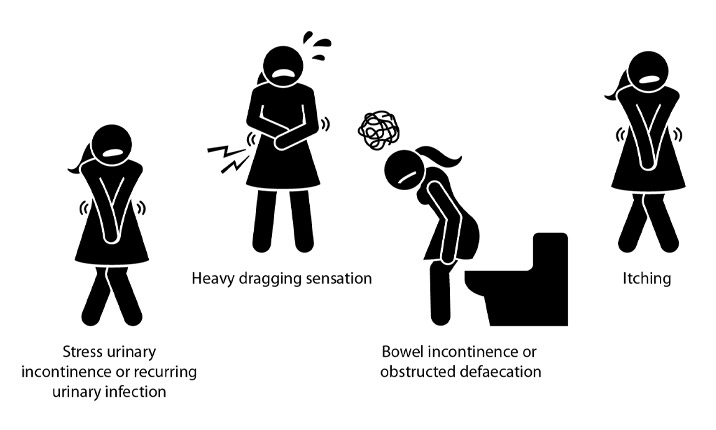Guest Blog: Pelvic Organ Prolapse- Causes, Symptoms, And Treatments


Every woman is born with a womb that is supported by a hammock made up of fan-shaped muscles called LevatorAni. These muscles are very strong and are covered with a sheath called fascia. This fascia or a thin layer of tissue condenses to form ropes-like structures called ligaments which attach laterally to the pelvic wall and supports the uterus or womb-like hammock strings. They together form the pelvic floor and prevent sagging of the womb, bladder, and rectum in a woman through the opening on this floor.
Any weakness of this system due to loss of strength of muscles or connective tissue is called Pelvic Floor Disorder.
Pelvic Organ Prolapse: (POP)
Pelvic organs are the uterus, bladder, and rectum. The bladder lies anterior to the uterus and the rectum lies behind the uterus. Whenever there is a weakness of pelvic floor muscles like LevatorAni it can lead to sagging of the uterus along with bladder and rectum collectively or in combination. The mouth of the uterus can be felt at the mouth of the vaginal opening on straining or squatting or at times much below the vaginal opening.
If the uterus keeps lying outside then it may develop into a mass with swelling and refuse to be pushed back inside by hand. This condition is called Pelvic Organ Prolapse.
Sometimes it can be seen in young girls who haven’t borne a child. This is due to defects in connective tissue leading to muscle weakness and nulliparous prolapse.
At times a ball-like structure is seen extruding from the vaginal area even after a woman has removed her uterus earlier. This is another entity called Vault prolapse where the supports of the vault are absent and it herniates out.
So pelvic organ prolapse is nothing but a hernia of a woman’s reproductive organ womb and the severity depends upon the degree of prolapse.
Causes of Pelvic Organ Prolapse:
There are many causes responsible for pelvic organ prolapse like
- Repeated Childbirth
- Instrument delivery like Forceps or Ventouse
- Difficult and prolonged labor
- Connective tissue Disorder
- Chronic constipation or Cough
- Improper hysterectomy technique
Symptoms of Pelvic Organ Prolapse:
Most symptoms are attributed to the degree of prolapse and the organ involved.
To enumerate a few
- Difficulty in passing urine / incomplete emptying.
- Constipation or incomplete evacuation
- Dragging pain in back
- Increased frequency of urination
- Leakage of urine on coughing
- Lump-like mass coming out of the vagina
- Bloody discharge per vagina
- Watery discharge per vagina
- Difficulty in walking.
Diagnosis of Pelvic Organ Prolapse:
Detailed History with any of the above symptoms:
Clinical examination by a doctor both in sleeping position and squatting position, Blood counts, Sugar fasting and Post meal, Urine test, Urodynamic study, USG pelvis by TVS and TAS, MRI Pelvis
Treatment of Pelvic Organ Prolapse:
Treatment is according to the severity of symptoms.
For grade 1:
Prolapse with little cystocoeleOne can be treated with pelvic floor exercise to tighten up your loose muscles. One is advised to alternatively contract and relax one’s Perineal muscles or anal sphincter just as one would do to hold urine.
Grade 2:
Prolapse with uterus sagging down a little with cystocoele or bladder Hernia . We can correct it vaginally by correction of cystocoele and correcting uterovaginal prolapse by Cervicopexy / pectopexy. This can be done by combined vaginal and laparoscopic/abdominal methods. A mesh is put around the cervix and it is anchored to the sacral bone. If uterus preservation is not desired one can opt for vaginal hysterectomy with cystocoele repair.
Grade 3:
Pelvic organ prolapse: Here the uterus is totally displaced outside the vagina. Here both bladder and rectal herniation can be present. Treatment is vaginal removal of the uterus and repair of bladder and rectal hernia.
A hospital stay is generally for 6-7 days. Alternatively, the uterus can be lifted up with help of mesh and both hernia can be corrected. This is done by laparoscopy an advanced laparoscopic unit. The hospital stay is 2-3 days. The success rate is high.
Vault prolapse:
Here the vagina gets everted after removal of uterus surgery earlier. This can be treated by Laparoscopic Sacrocolpopexywhere one lifts the apex of the vagina with a mesh and attaches it to the spinal bone. This is a very gratifying operation and results are immediately seen. Hospital stay1 day.
Stress Incontinence:
When there is a urine leak on coughing or straining we offer women a Laparoscopic Burch procedure whereby she is relieved of their symptom. Hospital stay1 day only. The same procedure can be done abdominally also where by stay is 6-7 days.
With the advent of the latest diagnostics and equipment, the treatment of POP has undergone massive change and can safely be done at centers equipped and manned by specialists to deal with it. So no more shunning public life for fear of leaking or organ coming out. Get your problems solved and enjoy life.
About the author- Dr.Aruna Tantia, Director and Consultant Surgeon (Gynaecology & Obstetrics), ILS Hospitals
